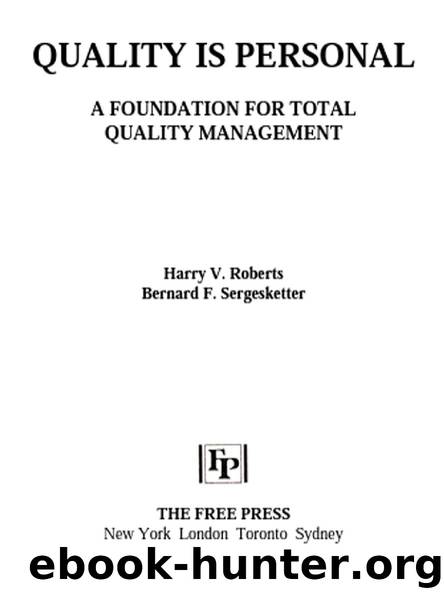QUALITY IS PERSONAL by Harry V. Roberts

Author:Harry V. Roberts
Language: eng
Format: epub
Publisher: The Free Press A Division of Simon & Schuster Inc.
Published: 1993-07-15T00:00:00+00:00
5. JUST-IN-TIME AT THE PERSONAL LEVEL
Quite apart from the applications thus far discussed, personal quality can serve as a vehicle for illustrating important TQM principles. We illustrate by a consideration of the issue, “Why the best batch size of a service process may be one”
There are important TQM ideas bearing upon the organization of production processes. These ideas are often grouped under the heading of “Just-In-Time” (JIT). They are easy to visualize in terms of manufacturing. They carry over to service processes, but the carryover is not easy to visualize. We shall now show how you might establish the carryover in terms of personal processes. We assume that some of your activities, like ours, are relatively small, frequent, and varied tasks. JIT concepts can help us to cope with them.
Consider an example from educational administration: the processing of requests for reconsideration by rejected MBA applicants in a business school. Replies to these requests were deferred until a substantial pile or batch had accumulated; then, in one sustained effort, replies were prepared and sent out. This is “batch processing,” which, according to TQM, is “bad.” It’s better to answer each request as it comes in; make the batch size one. This is one of the ideas of JIT processing. Is it counterintuitive?
A Simple Personal Example
Many of us can view our work in terms of incoming requests that have to be processed. For example, a student hands in a progress report on a Personal Quality Checklist project. The teacher’s task is to write detailed comments and suggestions on the report and return it to the student. It is desirable for the student to receive this feedback as quickly as possible.
The progress reports may be handed in at class, mailed or sent overnight, faxed, given to the teacher’s secretary, stuffed under the teacher’s office door, sent by E-mail, or hand delivered to the teacher’s office or mailbox.
Under batch processing, the teacher could accumulate reports until a convenient time, read them all at once, and return the batch of papers at a subsequent class session. Thus the teacher waits until he or she can switch to “paper reading” mode and apply full concentration to that task.
There are disadvantages to this batch approach:
• The teacher is accumulating an inventory, in the form of a pile of papers on the desk, which probably leaves less work space for other tasks.
• Some inventory management may be needed, for example, it may be convenient to alphabetize the papers.
• As the inventory builds up, the students are not getting feedback. They will be stuck with whatever misunderstanding and confusion they had when they wrote their reports.
• The teacher is handling each paper twice before processing can begin: it is put into inventory, then taken out to be processed. This is wasteful.
• As the papers are read in batch mode, an inventory of finished goods is built up. This, too, may require some management.
• Only a tiny part of the cycle time for each paper is spent in processing it. The rest is delay or storage.
Download
This site does not store any files on its server. We only index and link to content provided by other sites. Please contact the content providers to delete copyright contents if any and email us, we'll remove relevant links or contents immediately.
| Agile | Lean |
| Quality Control | Six Sigma |
| Total Quality Management |
Hit Refresh by Satya Nadella(8328)
The Compound Effect by Darren Hardy(7545)
Change Your Questions, Change Your Life by Marilee Adams(6635)
Nudge - Improving Decisions about Health, Wealth, and Happiness by Thaler Sunstein(6629)
The Black Swan by Nassim Nicholas Taleb(6182)
Daring Greatly by Brene Brown(5636)
Deep Work by Cal Newport(5452)
Principles: Life and Work by Ray Dalio(5315)
Rich Dad Poor Dad by Robert T. Kiyosaki(5140)
The Myth of the Strong Leader by Archie Brown(4785)
Man-made Catastrophes and Risk Information Concealment by Dmitry Chernov & Didier Sornette(4728)
Big Magic: Creative Living Beyond Fear by Elizabeth Gilbert(4717)
The Slight Edge by Jeff Olson(4716)
Discipline Equals Freedom by Jocko Willink(4629)
The Motivation Myth by Jeff Haden(4521)
Digital Minimalism by Cal Newport;(4509)
Stone's Rules by Roger Stone(4412)
Management Strategies for the Cloud Revolution: How Cloud Computing Is Transforming Business and Why You Can't Afford to Be Left Behind by Charles Babcock(4127)
The Doodle Revolution by Sunni Brown(4034)
